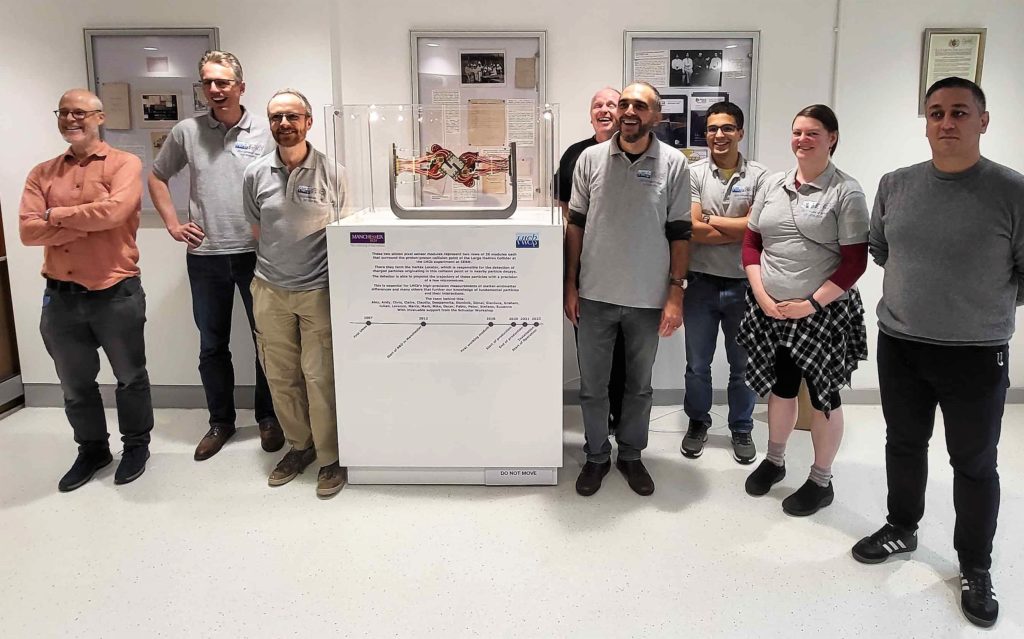You’ve probably heard of the Large Hadron Collider (LHC) – the 27 km circumference tunnel on the French-Swiss border, based at CERN*, the world’s largest particle physics laboratory. Most notably, the collider was where the Higgs Boson was discovered in 2012.
The LHC is clearly a major feat of engineering; what you may not know is that as well as academics from the University of Manchester playing a major role in the experiments that are taking place at CERN right now, fundamental pieces of the actual equipment used to perform these astonishing experiments are made right here, on the University campus itself.
Inside the LHC, the superconducting magnets housed within the ring accelerate particles to almost the speed of light, before colliding them with an accuracy equivalent to firing two needles from a distance of 10km apart and hitting the points! Equipment is then employed to track the results of those collisions at four points on the LHC, one of which is the “Large Hadron Collider beauty” (LHCb) experiment.
The LHCb specializes in investigating the slight differences between matter and antimatter by studying particles called the “beauty quark”, or “b quark”, and the “charm quark” or “c quark”. The experiment uses a series of subdetectors to detect mainly forward-going particles – those thrown forwards by the collision in one direction. The first subdetector is mounted surrounding the collision point, with the others following one behind the other over a length of 20 metres.
A small celebration was recently held in the Schuster Building, marking the end of a £12m project to manufacture Vertex Locator modules – the equipment which captures the results of these particle collisions – as part of a 3-year upgrade and maintenance project which is expected to improve the rate at which the experiment takes data by about a factor of ten. The team behind the manufacture of the modules brought together physicists, engineers, technicians, and students, who all played a vital role in the ten years from first ideas to construction

The team which built the Vertex Locators
Vertex Locator Modules are large electronic components. Once assembled, they are arranged in sequence, with half the modules interlaced with the other half, meaning a total of 52 modules, forming a small “tunnel” through which particles fly after the collisions in the LHC (see photo). Manchester was responsible for building about 80% of the modules which are used in the LHCb experiment.

A close up of a pair of Vertex Locators
You can hear more about the modules by listening to this extract (below) of an interview with Marco Gersabeck, which was carried out a few weeks ago. Marco, who works on the LHCb experiment, talks more about the manufacture of the modules – and if you’ve ever tried to glue a model aeroplane together, you’ll want to hear him talk about gluing sensors to circuitry with micron level precision!
Transcript of the audio discussion with Marco Gersabeck (PDF document)
If this has whetted your appetite to learn more about CERN, the LHC, and the experiments that our scientists are leading there, then watch this space. Over the next few weeks, we’ll be running a mini-series about the work Manchester scientists are doing on the LHC. We’ll be talking more to Marco about the work he does, as well as Will Bertsche, who works on the Alpha experiment, and Jonathan Langford, an undergraduate from the University whose career has gone from strength to strength, including an extended period working at CERN, since graduating in 2017. Next time, however, we introduce the series by talking to Chris Parkes who is the leader of the LHCb experiment. Don’t miss it.
* CERN, in French, stands for “Conseil Européen pour la Recherche Nucléaire”
Words: Dave Espley

Comments
5 responses to “Building equipment for the Large Hadron Collider”
PROUD TO KNOW THAT MANCHESTER UNIVERSITY SCIENTISTS ARE BUILDING EQUIPMENT FOR LARGE HADRON COLLIDER AT CERN.WE HOPE THAT OUR UNIVERSITY OF MANCHESTER EQUIPMENTS WILL UNRAVEL MYSTERIES OF OUR UNIVERSE AND BEYOND!
I would not have believed, when attending my Physics lectures back in 1952, that such strides would be made by Manchester graduates et al during my lifetime.
I never quite realised at the time just how exceptional Manchester University was and moreover how lucky I was. I trust that my granddaughter, a more recent graduate with an albeit much higher debt, did.
Cern was developed after World War II in a spirit of international cooperation. Brexit has diverted attention away from the work of Cern and this has also harmed science. Brexit has put off a lot of scientists from coming to the United Kingdom. That Higgs Boson was developed at Cern shows how important international cooperation is to science.
Goodmorning: CERN
I am so excited to read about this.
Soon we will learn more. Things are
happening so fast. Or is that we are
discovering too slow? Time, matter,
Antimatter, gravity, knowledge, and
energy, must be the key. I want to
learn more.
Have a nice day.
I’m proud to have been part of this. The long hours in the clean room on the 5th floor have paid off.